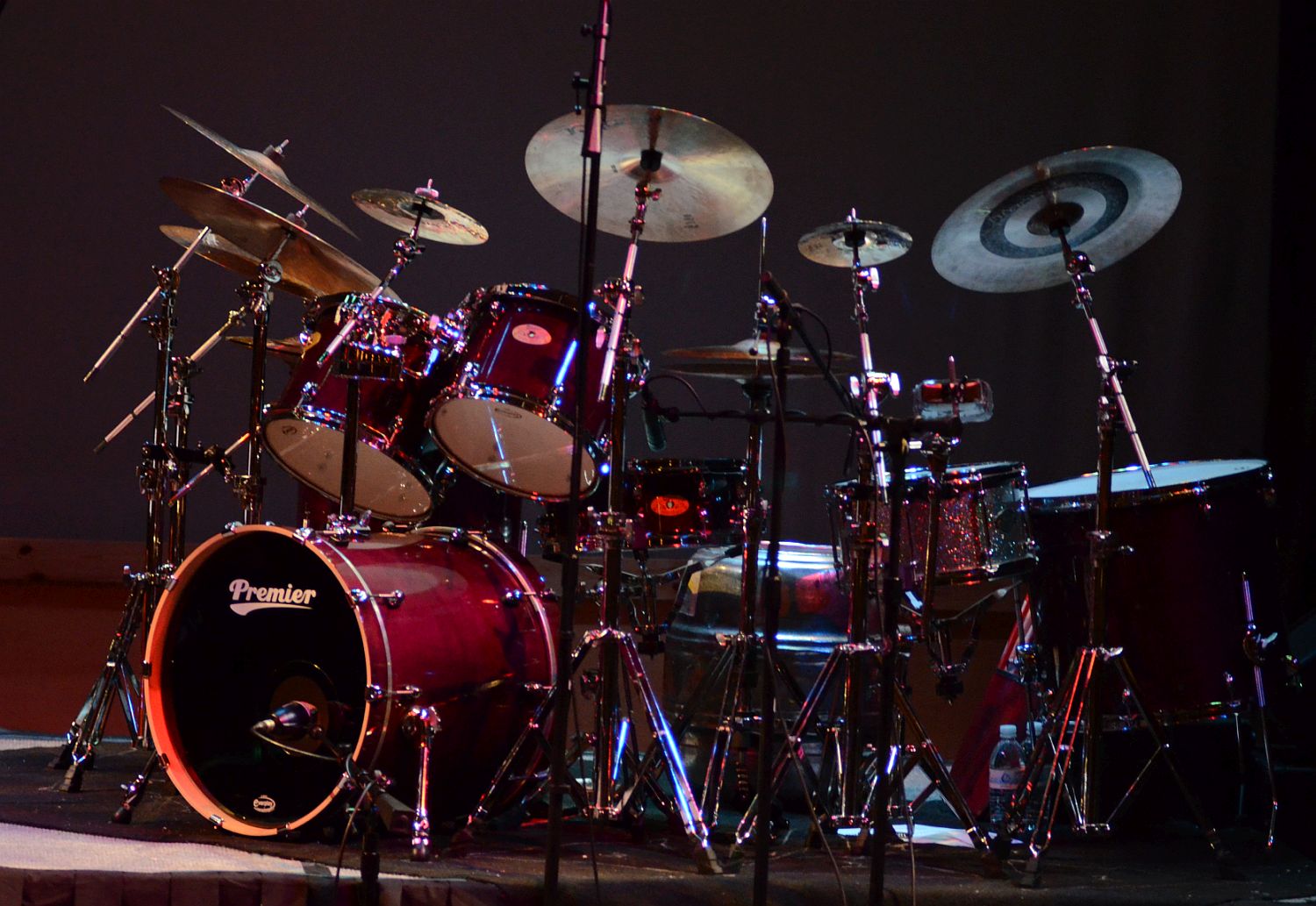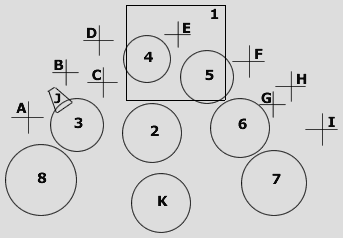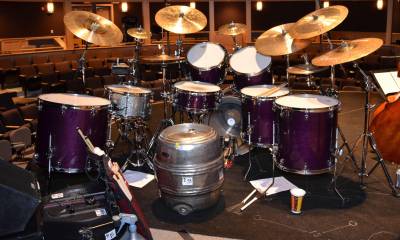Gear Info
What I play & why

Timm Biery hits Remo Heads on Premier Drums and various metallic instruments with Pro-Mark and Vic Firth Sticks
That statement, in one form or another, has appeared on virtually every album I’ve done since 1994. Over the years, little things have changed from project to project, artist to artist, but they have remained fairly consistent. I get a lot of questions about what I use and why I use it. Hopefully, the info on this page will answer those questions in far greater detail than I can provide with individual responses. If, after reading this page, you still have specific questions relating to my kit or why I chose a certain thing in a particular situation, send me an email. I’ll be happy to answer to the best of my memory.
Drums
In 1994, I made the move to Premier Drums. I think it was a great decision. In my humble opinion, Premier builds some of the best drums you can find today. And their products just keep getting better! Over the past several years, I’ve changed my set up a bit to allow me to move in some different musical directions. My main studio kit is from the Signia series, circa 1994. Here’s a diagram outlining the current configuration I’m using...
- 18x20 or 18x22 Kick
- 5.5x14 Signia maple snare (wood hoops)
- 7x13 Modern Classic maple snare
- 9x12 Rack Tom
- 10x13 Rack Tom
- 14x14 Floor Tom
- 16x16 Floor Tom
- 16x18 Floor Tom
Cymbals
I began an association with Istanbul Mehmet in late 2007 which ended late in 2015. My search for more unique sounds has led me to look elsewhere. And while I’m grateful for the support I received from the folks at I.M., their focus has diverged from mine significantly. They make absolutely beautiful instruments, many of which I still use, and I urge you to include them in your list of manufacturers to check out if you’re searching to modify or update your rig.
Here’s the kit diagram again, listing my last Istanbul Mehmet set-up:

- 18" Sultan China
- 8" Radiant Splash
- 13.5" X-Jazz Hi-Hat
- 16" Traditional Dark Crash
- 10" X-Metal Splash
- 21" Traditional Dry Custom Ride
- 12" Sultan Hi-Hat
- 18" Traditional Dark Crash
- 19" Xperience X-FX or 18" X-Jazz Crash
I’ll update this shortly with the rig I used for the majority of my new album.
Hardware
All of my hardware (with minor exceptions) is made by Premier. The new set up is basically an update of the configuration I’ve used for many years, with one addition. It consists of five 6000 series boom cymbal stands, one 6000 series “straight” cymbal stand, the “Rok-Lok” double tom holder with a boom arm add on for the center splash, hi-hat stands from the 6000 and 4000 series, two 6000 series snare stands and my custom built cowbell holder (by Rich King and Noel White). The new addition is Premier’s “X-Hat”, which is supported by one of their fantastic large multi-clamps. I’ve been practicing with one of their 6000 series double kick drum pedals and I have to say I like it a lot. I’ve never played a double pedal before (I guess I’m more old school than I like to admit), and I’ve worked very hard throughout my career to have a right foot that didn’t need any help (so to speak). I have a feeling, however, that this pedal will find its way onto a record in the near future, then I’ll be committed to using it on a tour. Until then, I’m going with my old reliable DW 5000 double chain pedals. They’re of the “Turbo/Accelerator” variety, and I’ve gotten so accustomed to their feel, it’s difficult to make a change. Thankfully, the kind folks at Premier don’t seem to have a problem with me using what I need to. I am mulling a couple possible additions to the set up before touring begins, and I’ll post any updated info here.
Heads
I’ve used Remo heads since the start of my playing days. What I’m looking for in a head is as open a sound as possible - no deadening whatsoever, if at all possible. I like the drums to sound a bit like a jazz kit to me, but I want the front of house folks to be able to get the sound they need for any given situation. This approach makes life a bit more difficult sometimes, as overtones can be a problem in certain live settings. Over the years, however, I’ve learned how to take care of that through tuning. Rarely do we use any dampening (i.e. Moon gel, duct tape), and we try never to use electronic “gating”. A big factor in this is micing, which I’ll discuss in a moment. For now, let’s talk head selection.
For the remainder of this discussion, feel free to insert the words “single-ply head” wherever you see the word “Ambassador”. Likewise, you can use “double-ply head” where you see the words “Emperor” or “Pinstripe”. With that in mind, let’s move on...
In the studio (as you can see from various gallery photos), I almost always use Remo Ambassadors on the snares and toms. To me, kits with thin shells (Premier, Slingerland, Gretsch as examples) can feel and sound a bit choked with thicker heads such as Emperors. And while I’ve used practically every head combination you can think of over the years, I always find myself coming back to Ambassadors in the studio. You can mold an Ambassador into virtually any sound, but you can’t make a Pinstripe head sound open with a lot of overtones.
In live situations, I often move to CS Black Dots on the batter side of the toms. These heads give me the thinness of an Ambassador with the added benefit of lasting quite a bit longer (for me, anyway). These heads have slightly more attack as well, which can help the toms cut through in loud rock situations. I also use these heads occasionally in the studio, too, particularly if I'm tuning the kit a bit higher, ala Tony Williams. And they respond in a similar fashion to Ambassadors if the rare need arises to dampen the sustain a bit.
Kick drums are another matter entirely. I use the same heads live as I do in the studio 99.99% of the time. For the past several years, that choice has been a Remo Powerstroke. Start with a Powerstroke (or similar head from another manufacturer) and you’re well on your way to a good sound. For live and the studio, all I do is use a Powerstroke and a front head with a hole. Premier front heads are dampened in a similar fashion to a Powerstroke (in fact, I think they are Powerstrokes), so that makes life easier. Usually, all I need to do is throw a small piece of material (like a bandana) into the drum to kill the “inner tube” sound that’s sometimes there, and I’m ready to go. I use no other direct dampening at all.
Sticks
Since the late 1970’s, I’ve used Pro-Mark 808 Wood Tip sticks. I used Oak at first, then Golden Oak through the Mahogany Rush days. In the mid 80’s, I switched to Hickory. They seem to last a bit longer and they’re much easier on my hands. After trying several different sizes (and brands) of sticks these past few months, I wound up returning to the 808’s. I guess my hands have become so accustomed to them over the years I can’t seem to change! I also use several types of Pro-Mark Rods, Vic Firth Brushes and Mallets.
Mics
I’ve always wanted to control as much of my sound as possible. Guitar players, bass players, keyboard players - they get to have so much control of their sound it’s not even funny! Why not drummers? This was how I felt for years, and I think, finally, microphone companies listened to all of the drummers out there crying out for more control. With every catalog from online retailers for example, I see more and more “drum micing packages” available at reasonable prices. That’s a very good thing! But you must be careful when choosing a package such as these. It is unfortunate that we can’t take our kits into the music store, set them up, mic them up and play until we can decide if what we hear is what we want to sound like. Because we can’t, it’s important to ask around, search out other drummers opinions and see what the drummers you like are using. Even then, do your best to get a return guarantee on whatever package you buy! Believe me - what sounds great on one kit in an arena may not sound great on your kit at the local bar. Remember, it’s all in the hands - we all sound different from one another, even on the very same kit.
Years of recording and touring have given me pretty firm opinions about what I want from a mic. I want clarity. I want them to be almost invisible, imparting little or no additional tone to my sound. I want them to have a very “low profile”, so there are no extra stands hanging over everything. I want the clamps to be extremely low mass, not choking the drum in any way (very important for users of thin drums). And I need them to be rugged. Really rugged.
When I came on the Danny Gatton Band in the early 90’s, he’d just gotten an endorsement deal with Shure mics. One day, a package arrived at a gig filled to the brim with all of their latest mics. Needless to say, everyone had a field day! When I saw the drum mics - SM 98’s for the toms, an SM 91 for the kick drum, Beta 57’s for the snares - I was curious as to how these would sound. Until that time, I’d been accustomed to using Sennheiser 421’s & 441’s, EV RE 20’s, AKG D-12’s & D-112’s and, of course, the ever present SM 57’s on snares. Well, let me tell you, they blew me away on the gig that night. I could hear the clarity - even through the monitors! What a change it was. I asked Danny if I could use them in the studio to really check them out. He agreed, and off I went with a box full of mics. My studio assistant and I put them through a bevy of A/B testing over the next several days. We tried them on a variety of kits and different head combinations. The 98’s and the 91 were winners in every test we ran. We went through over 20 SM 57’s and found 2 that were remarkably better than the others on snares. We then went through about the same number of Beta 57’s (the first generation Beta mics), and found 1 that was better than the rest on snares. Since those tests, I’ve been sold on those mics. I’ve been using my Shure mics for over 10 years now, and everyone who hears them is amazed by their sound. Mind you, whenever I’ve gotten new mics into the studio, we’ve tested them and always found 1 or 2 to be better on snares or better on guitars. And I like the older, thinner cables on the 98’s and 91’s (which is sometimes a drag for the crew!). But they are everything I look for in a mic, and I think they’re a big part of my sound. That’s why I take them nearly everywhere I go.
To run down my complete mic set up:
- Kick drum: SM 91 (lays in the drum on a piece of studio foam that doesn’t touch the heads)
- Main snare: Beta 57 or SM 57 (depending on the drum - a darker drum gets a Beta, a brighter drum gets a 57)
- Snare 2: Beta 57 or SM 57 (same criteria as above)
- All toms: SM 98’s (with Shure clamps and goosenecks)
- Overheads: SM 81’s or Audio Technica ATM 4033’s
- Hi Hat: SM 81 (in my studio, I often use an old Sony condenser that I’ve had for years. Don’t know the model #)
One last note: I do, in fact, sit on a beer keg. I’ve done this since I was around 15 years old and it’s far more practical than you might think. In those days, drum thrones weren’t nearly as well made as they are today and I was breaking one after the other. I had a gig coming up, but couldn’t fix my throne and had no money to buy a new one. I’d acquired a keg (we won’t go into how) some months before and tried sitting on it while I played. The height was right, it was solid as a rock, and not at all uncomfortable. At first, I used a cushion on top. Over time, this disappeared, though sometimes my drum tech’s have fashioned one out of foam to use for a tour. If you’re into specifics, the kegs I use (I actually have 3) are Budweiser 3/4 kegs (not too many of these around anymore). When we were in New York with Nils during the Breakaway Angel Tour, one of the stage hands remarked on the keg and said “Oh, I get it - Biery / Beer Keg”. Believe it or not, I’d never thought of that before, but the keg certainly has become something of a trademark of mine.
I hope this page answers some of the many equipment questions I’m asked. As I said earlier, I’ll keep it updated as things evolve...
